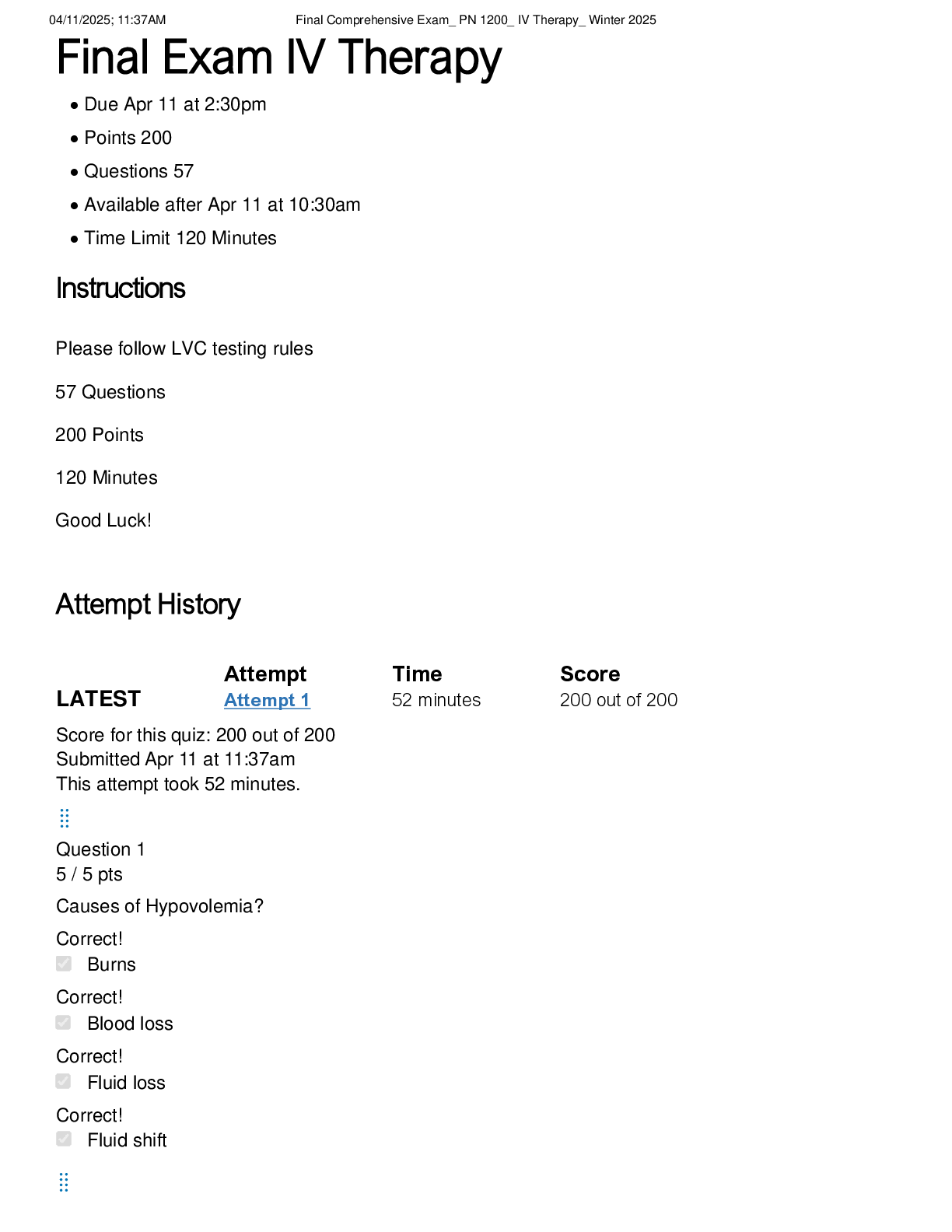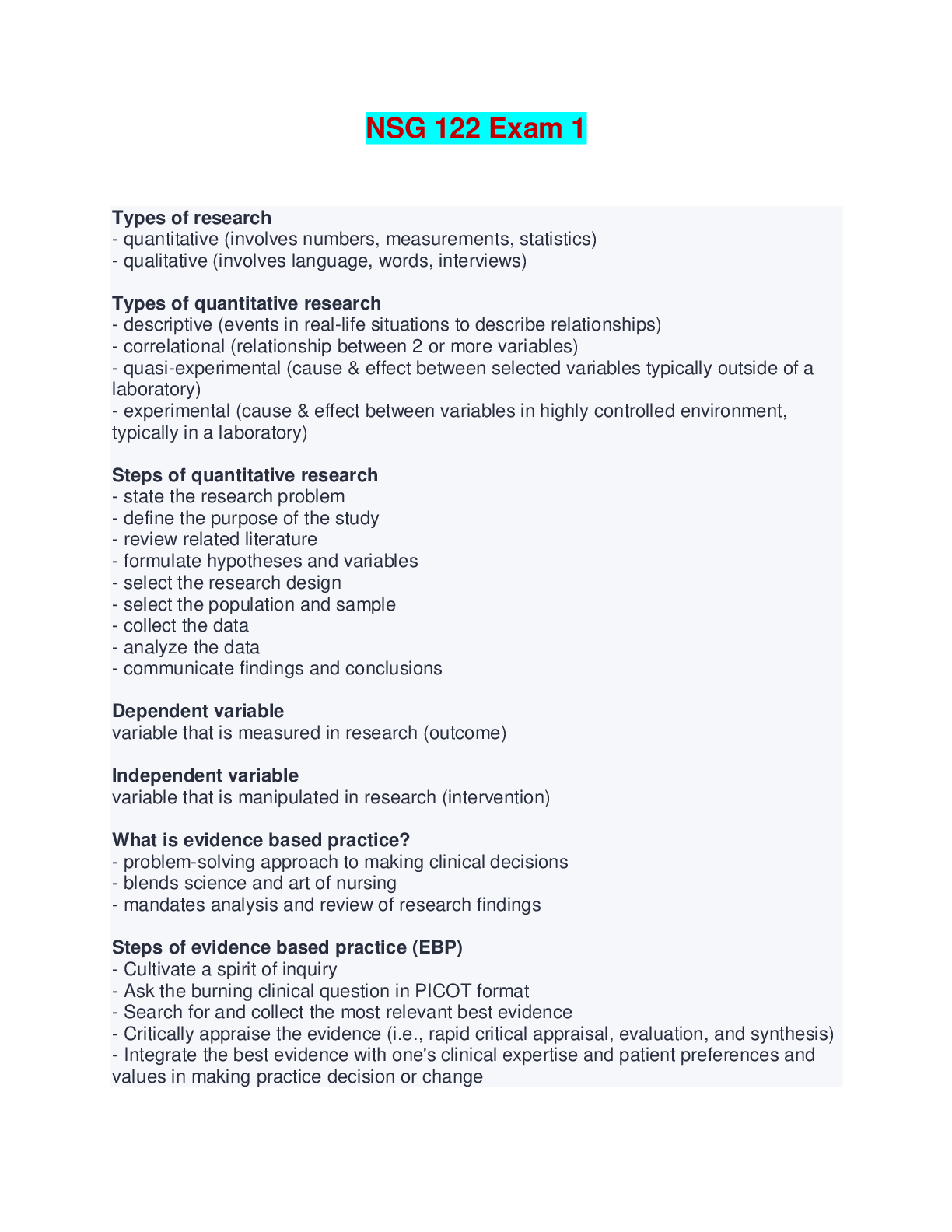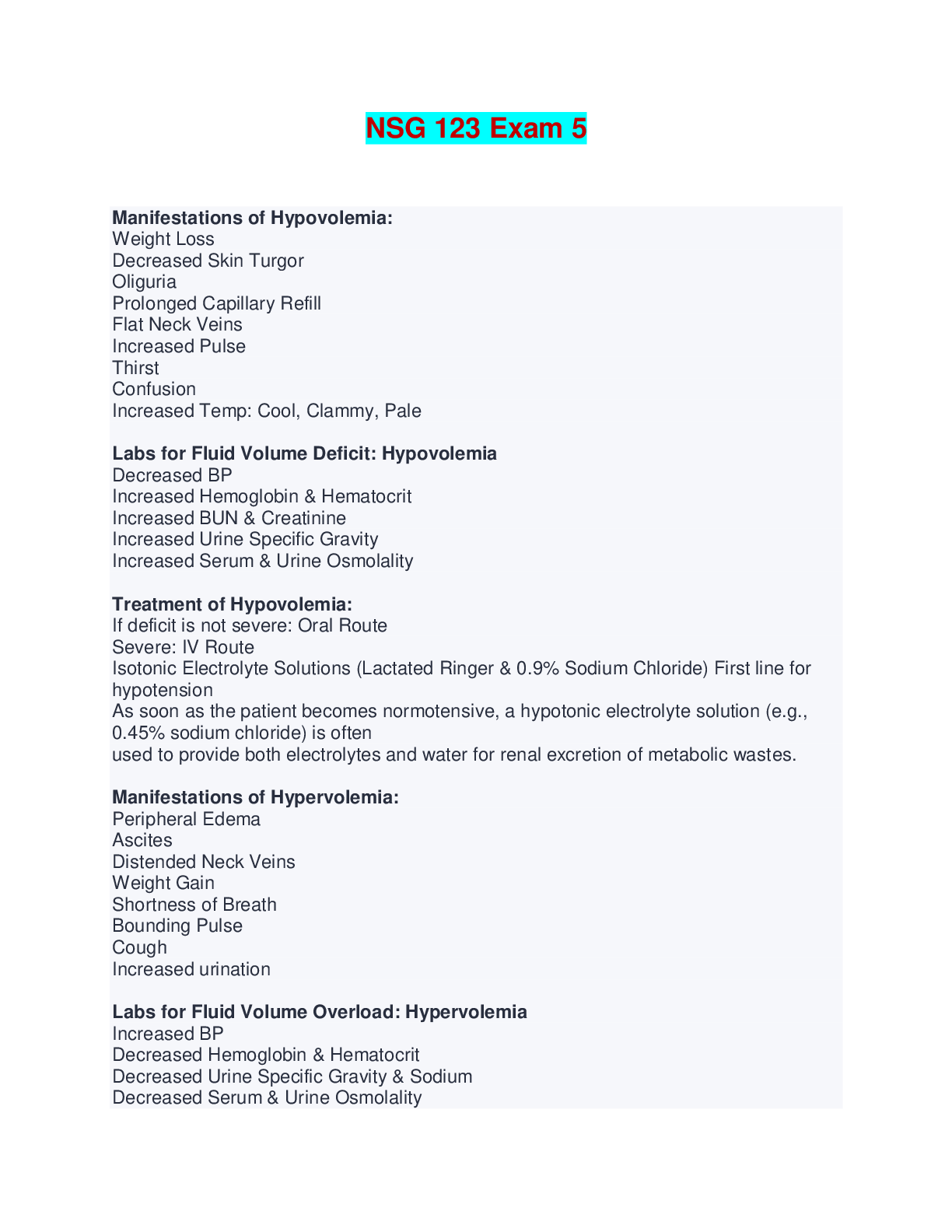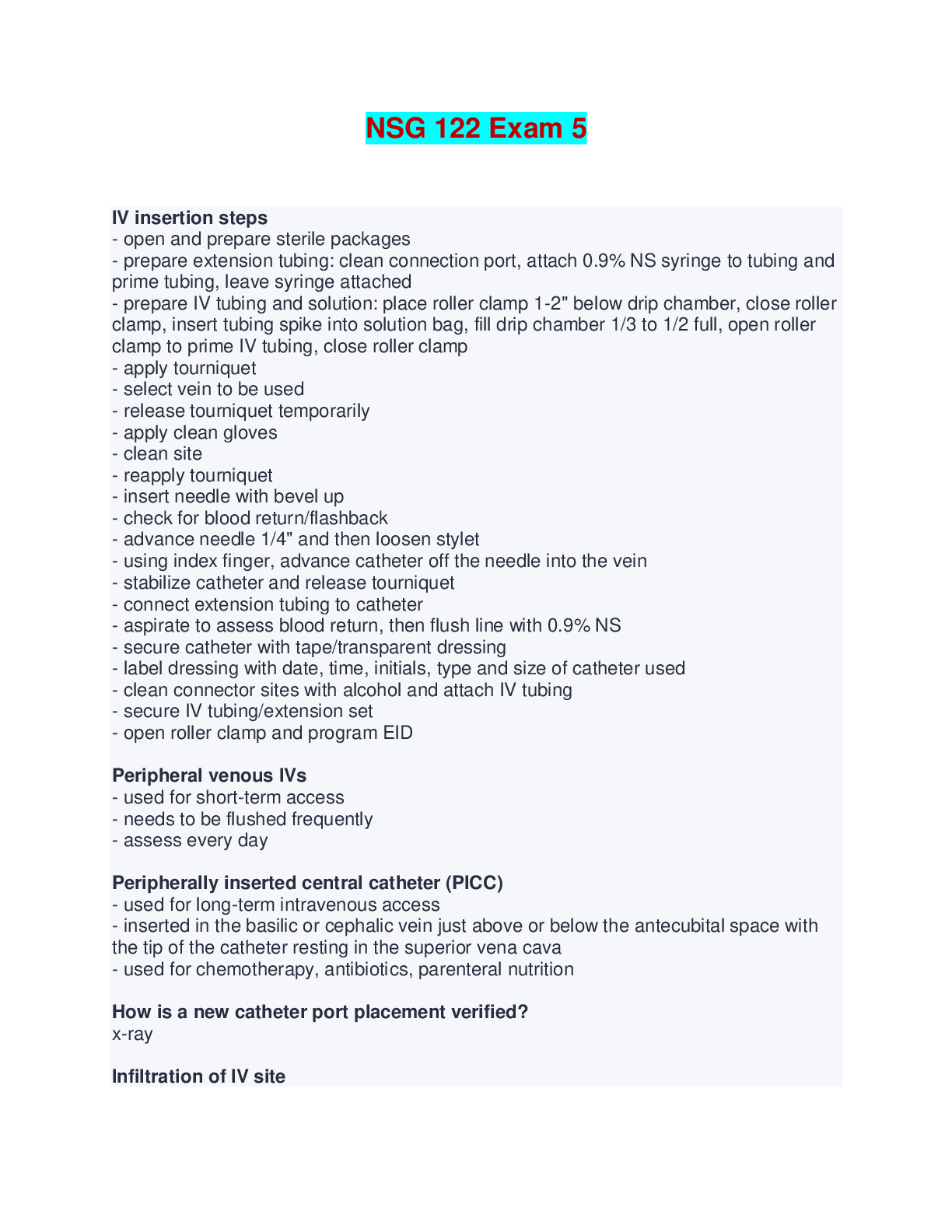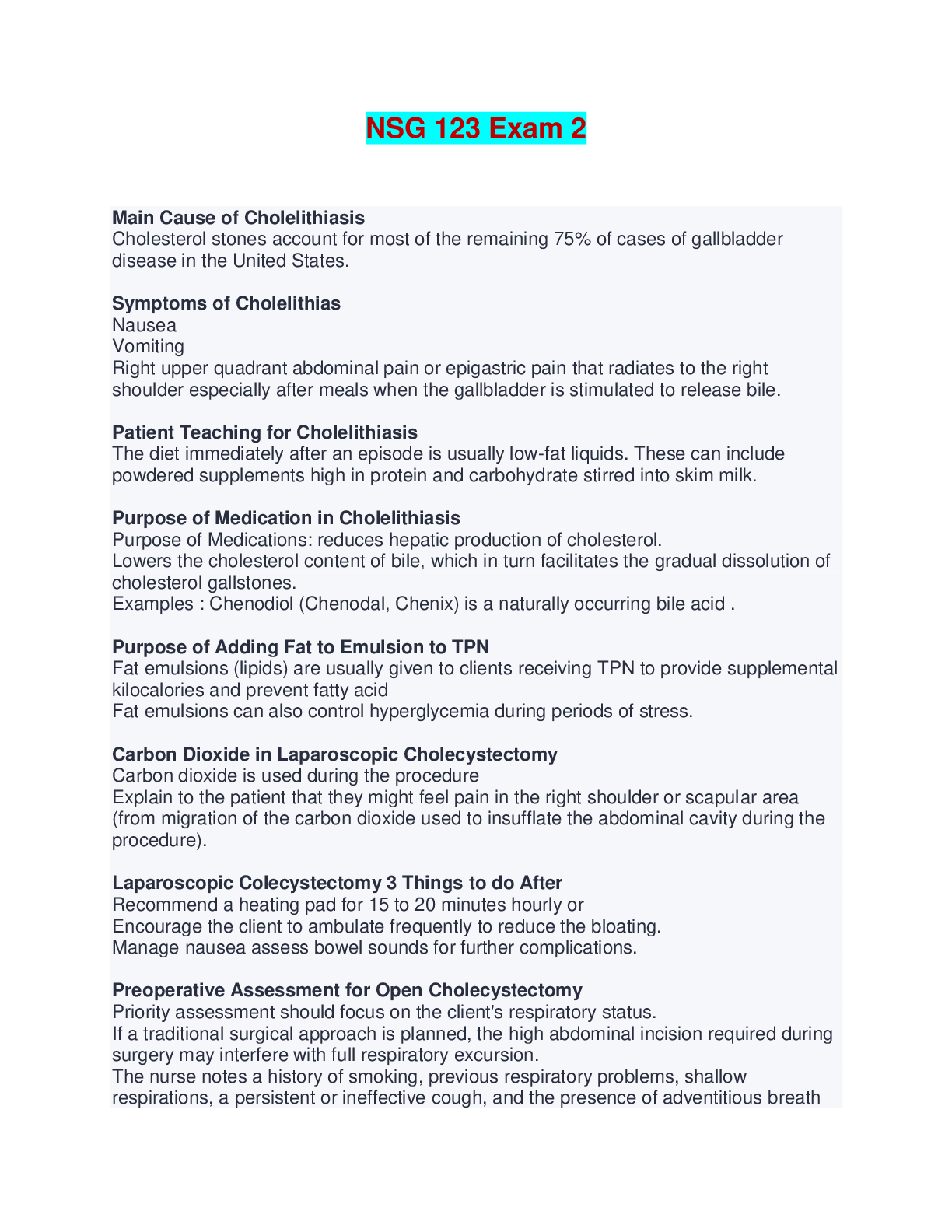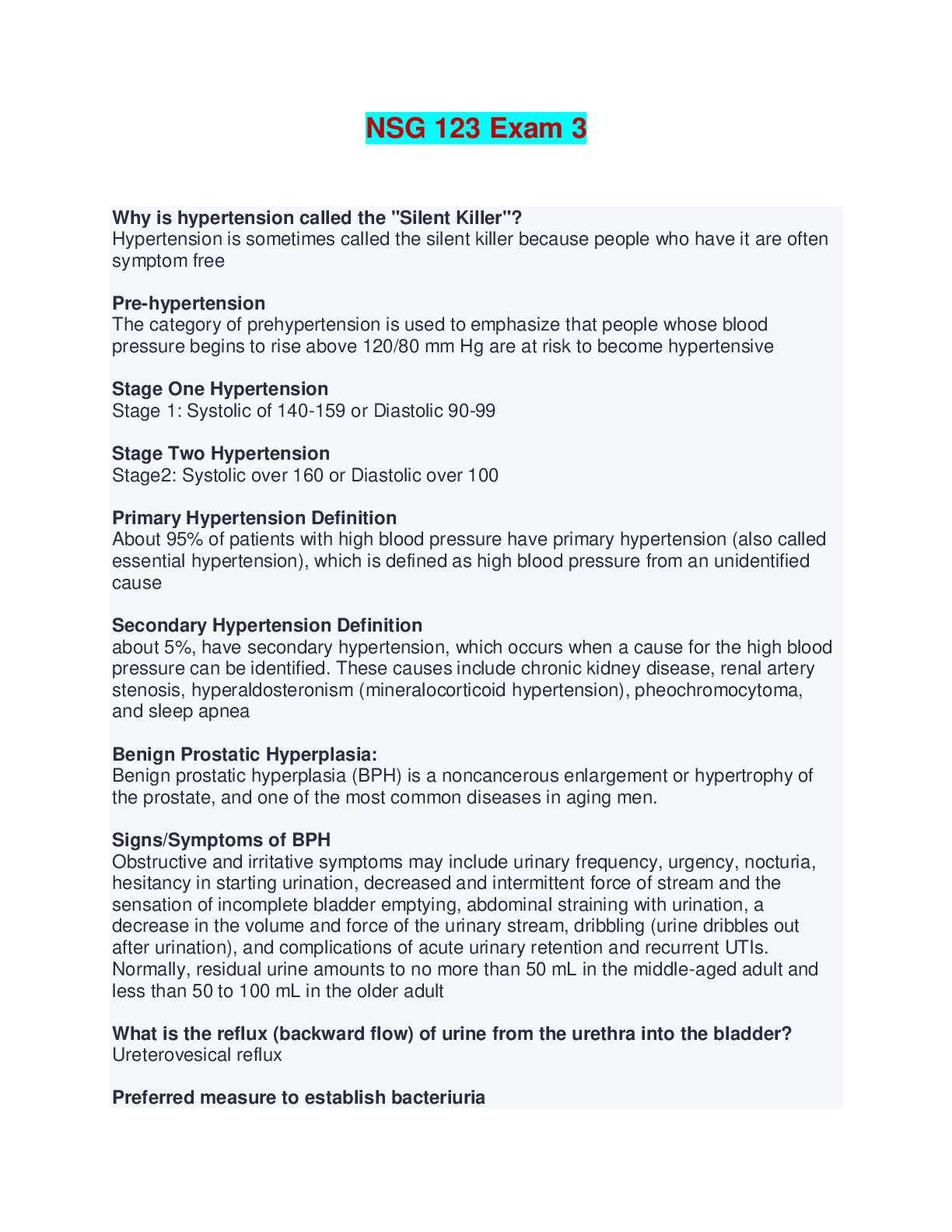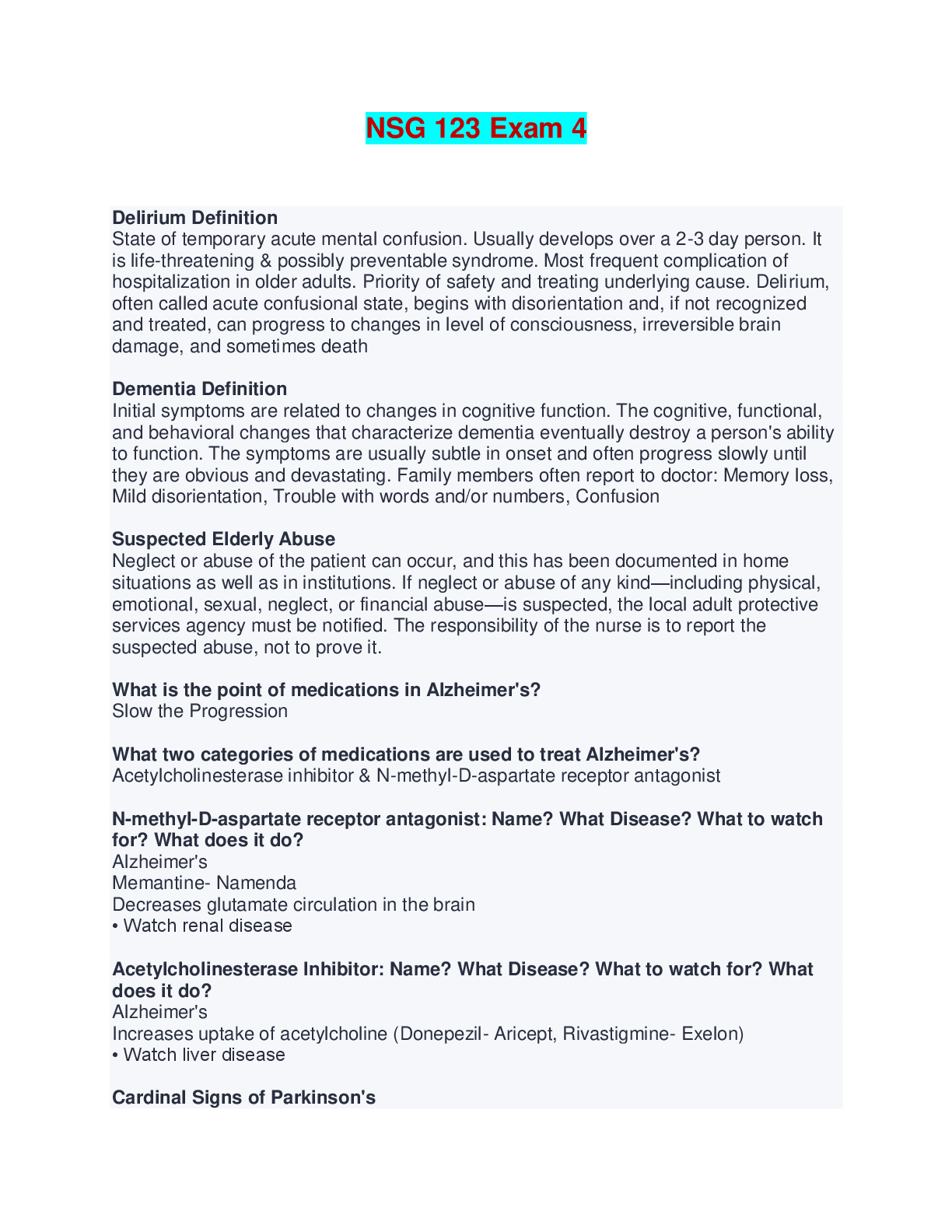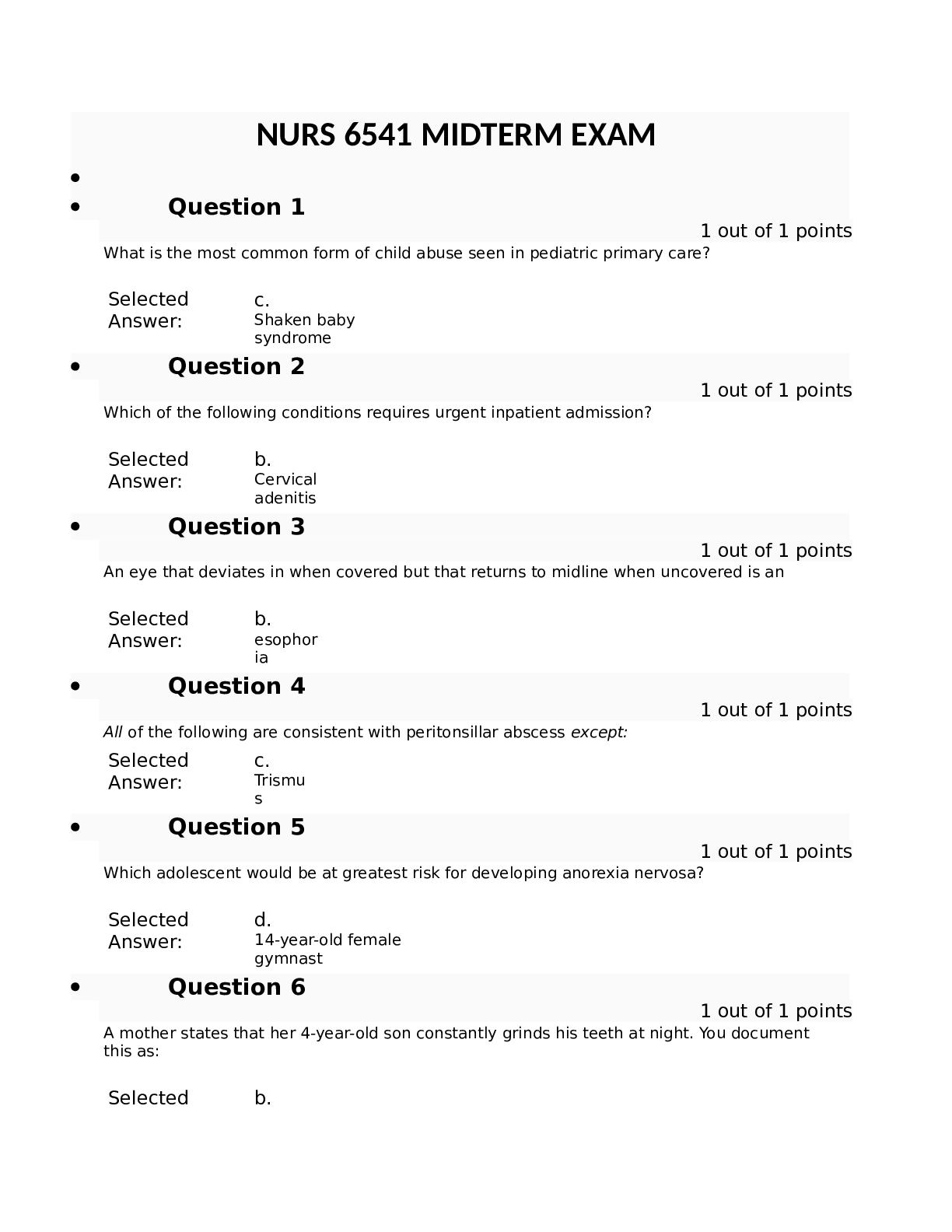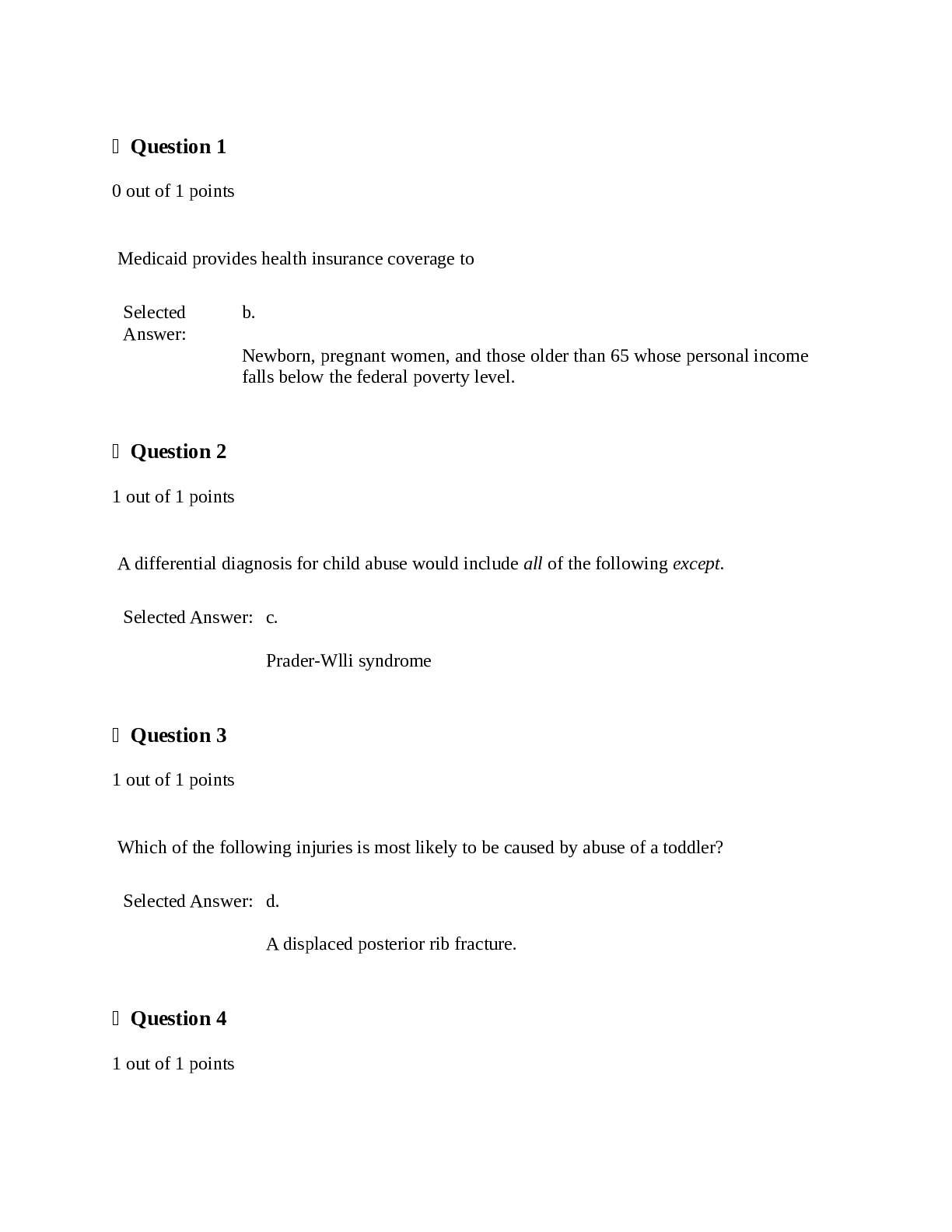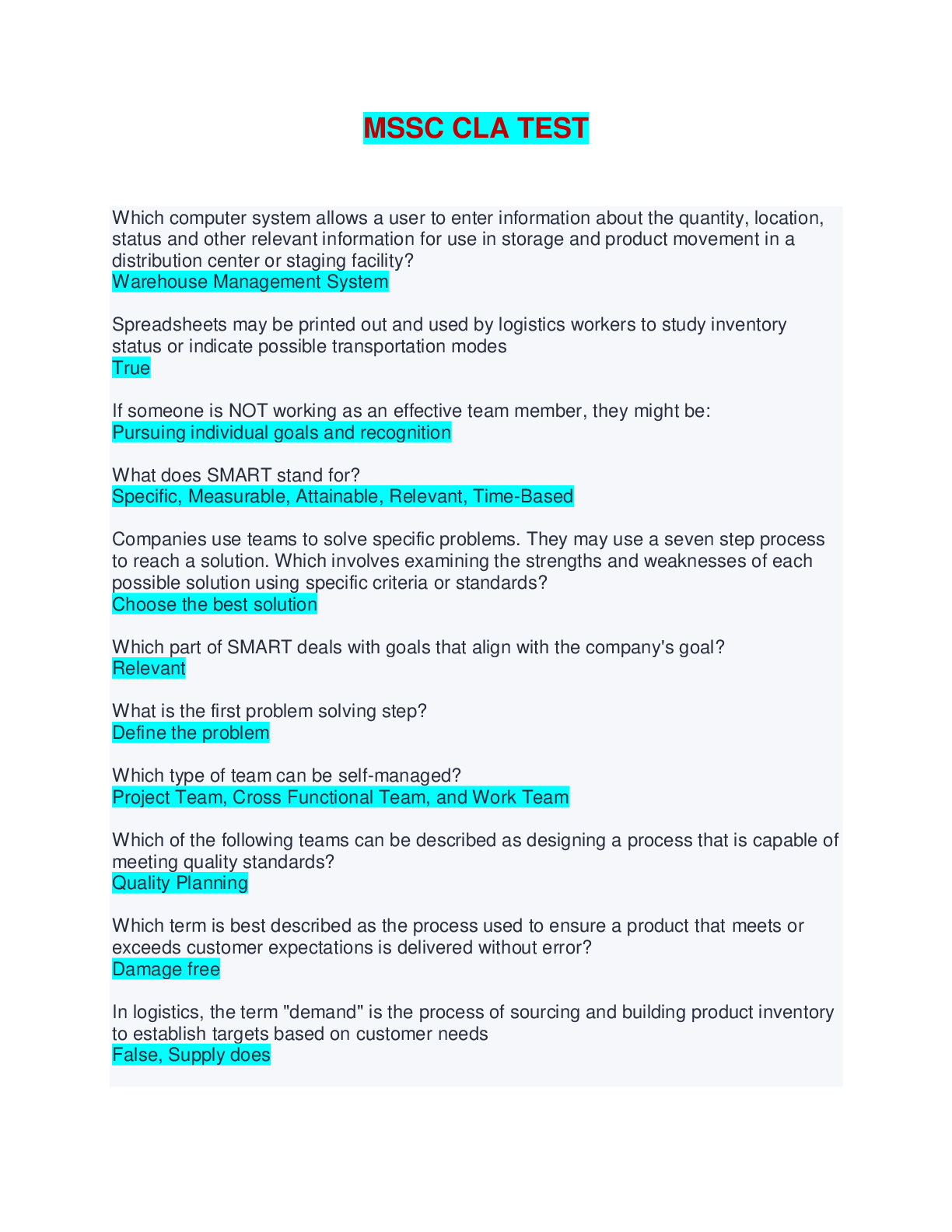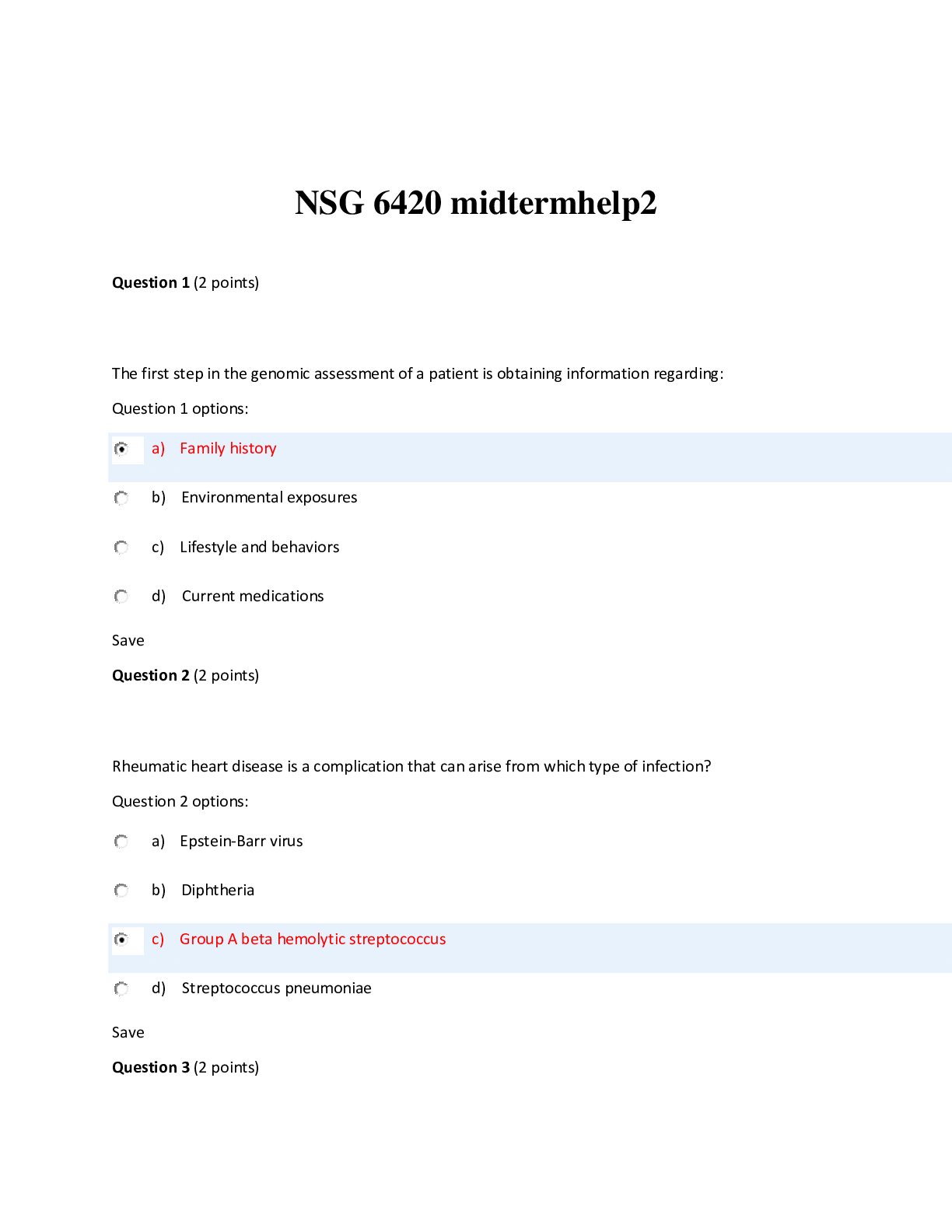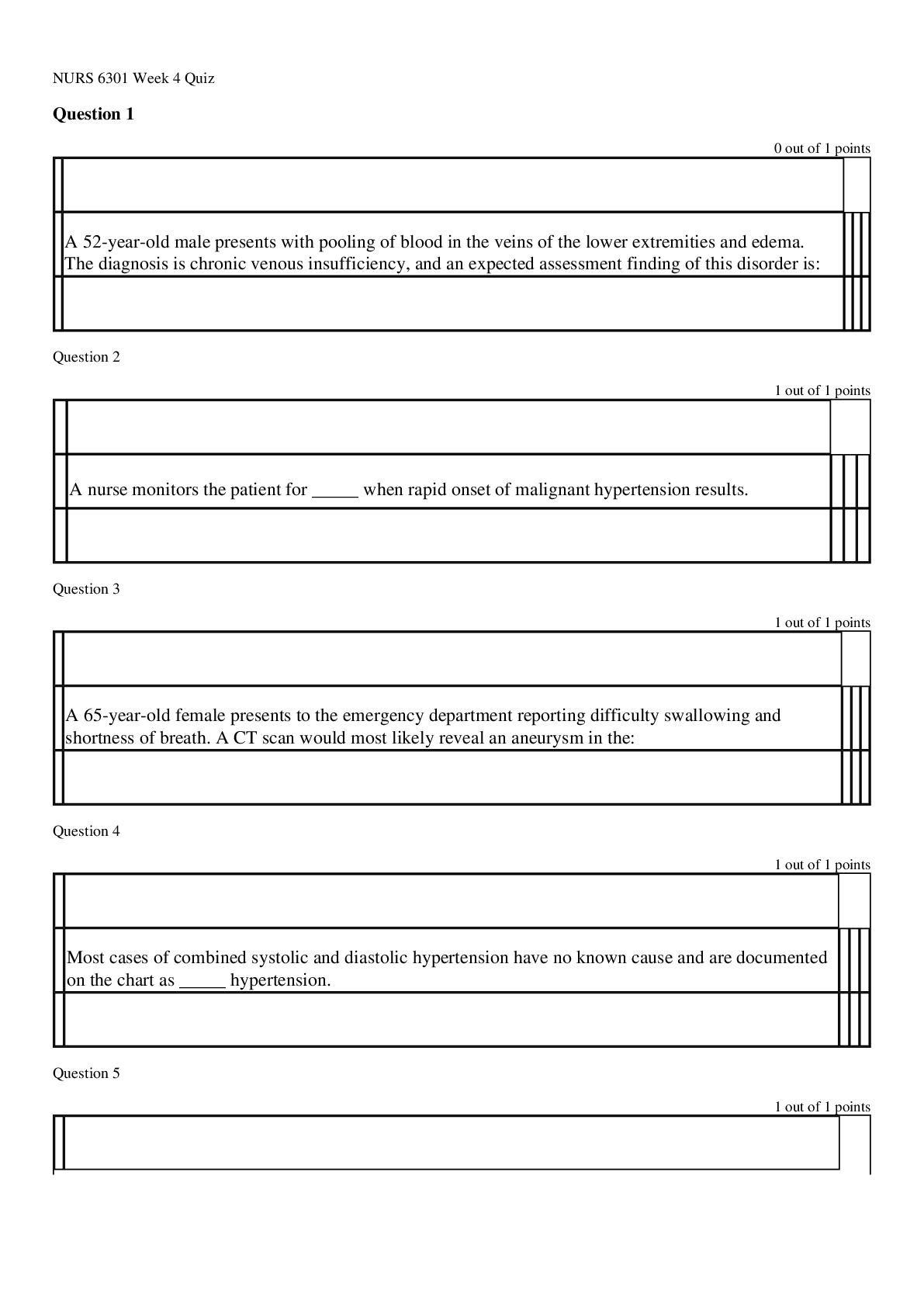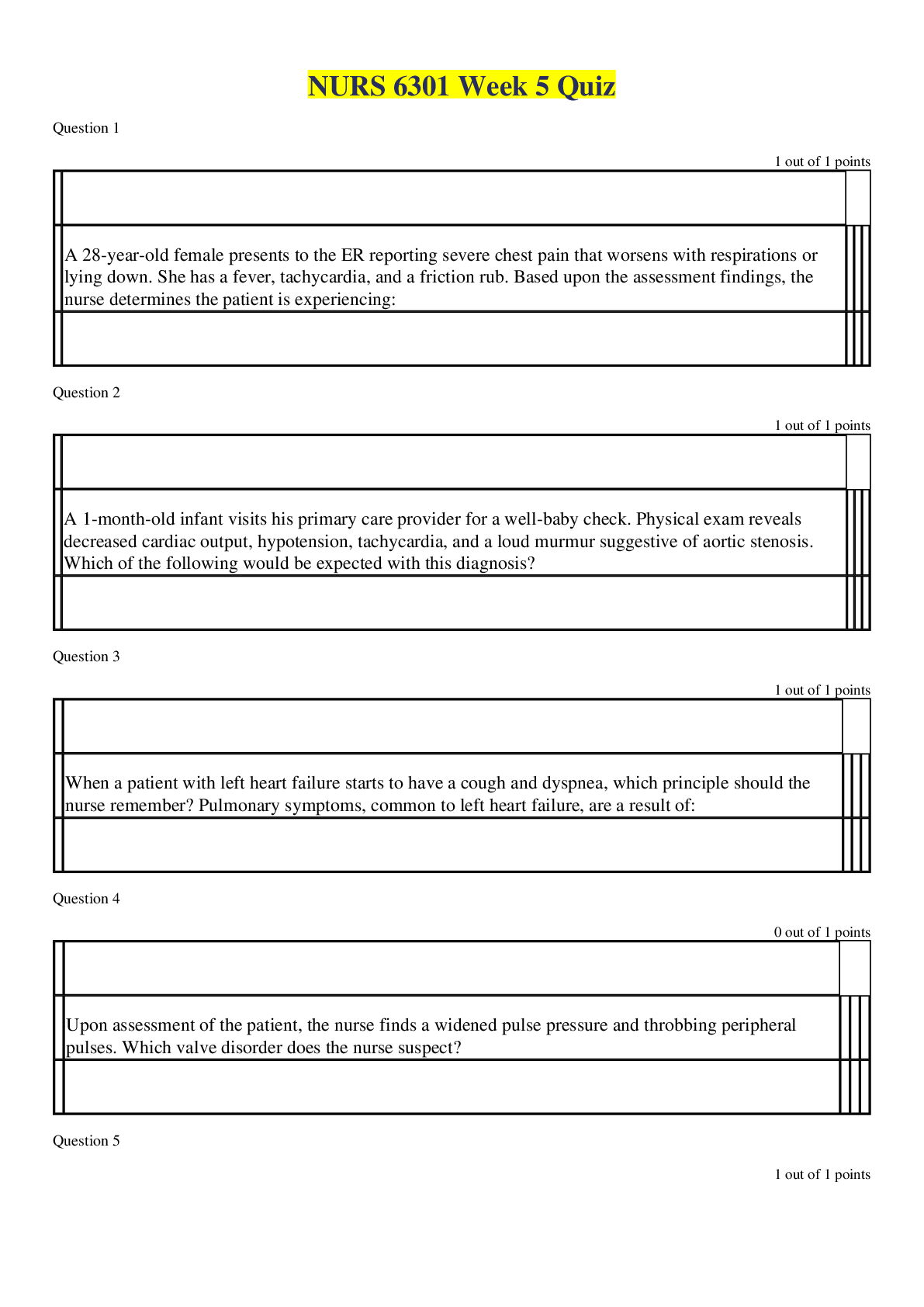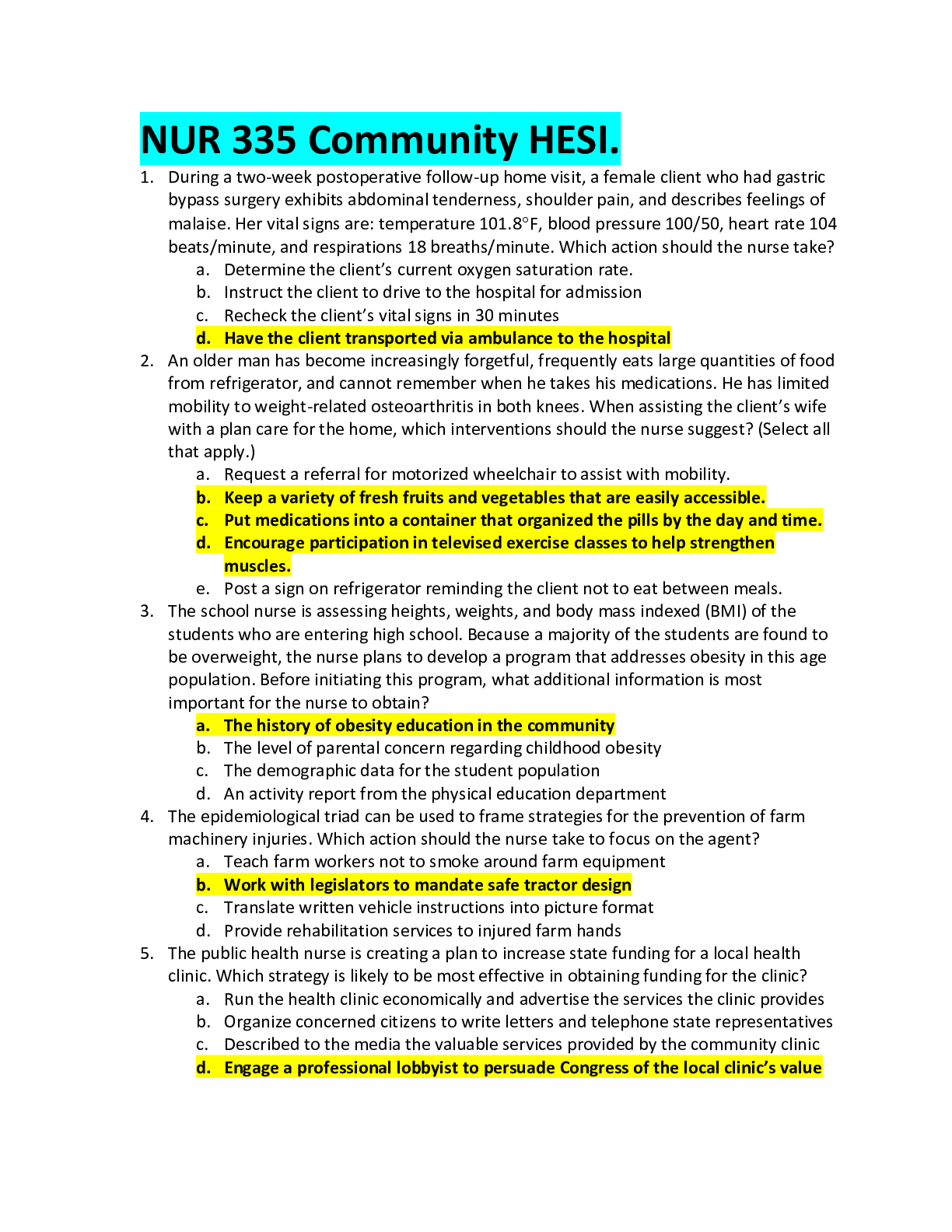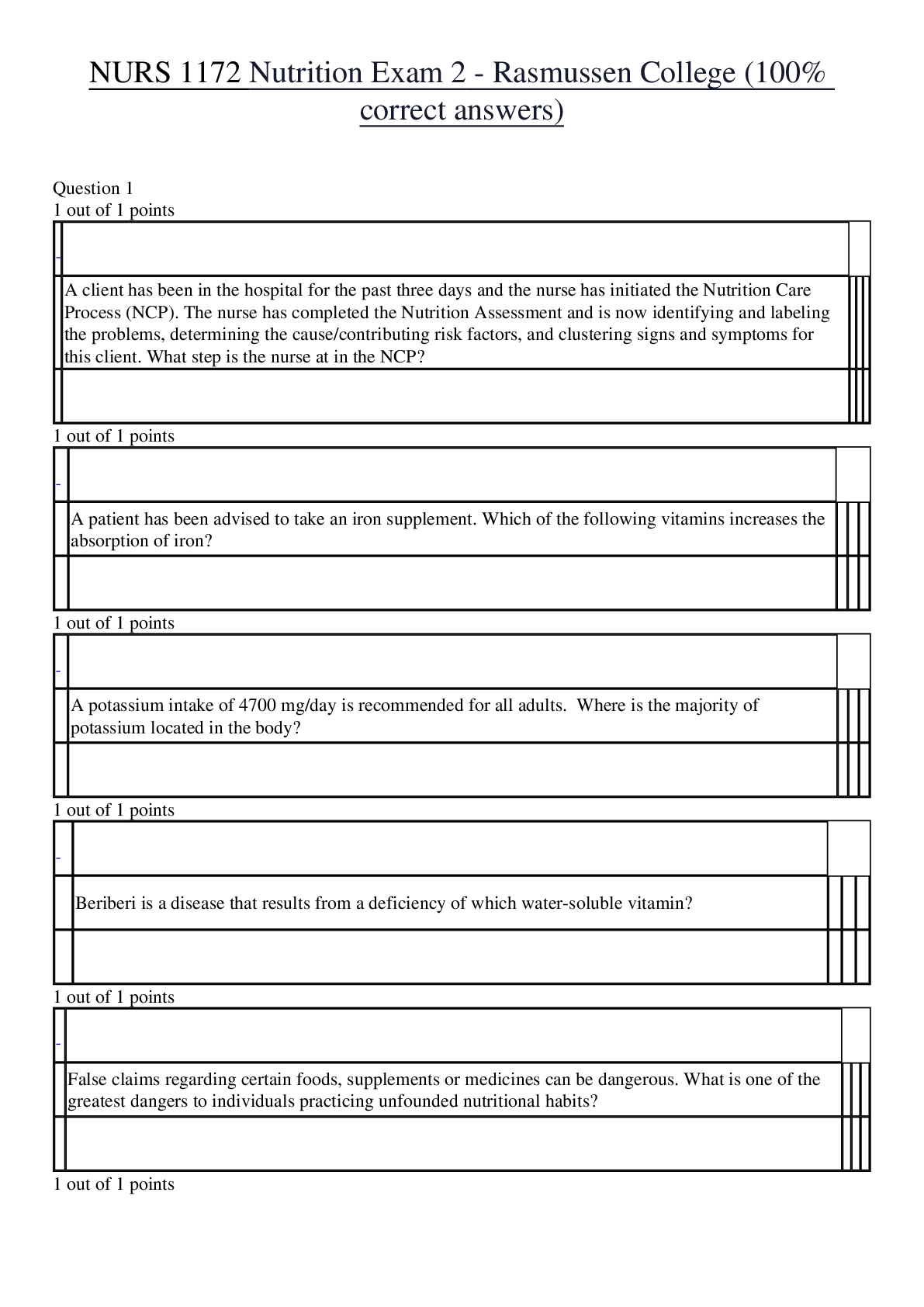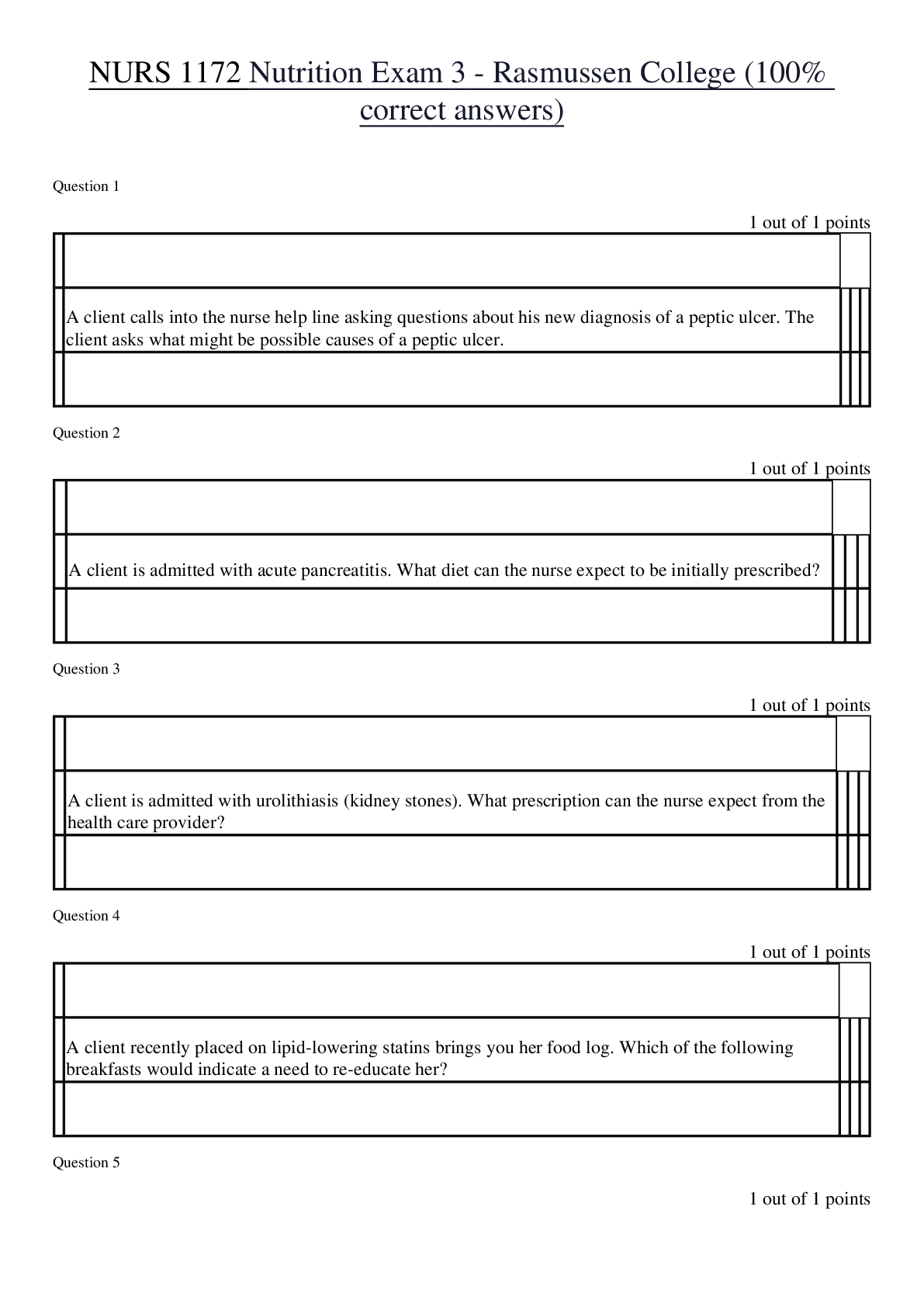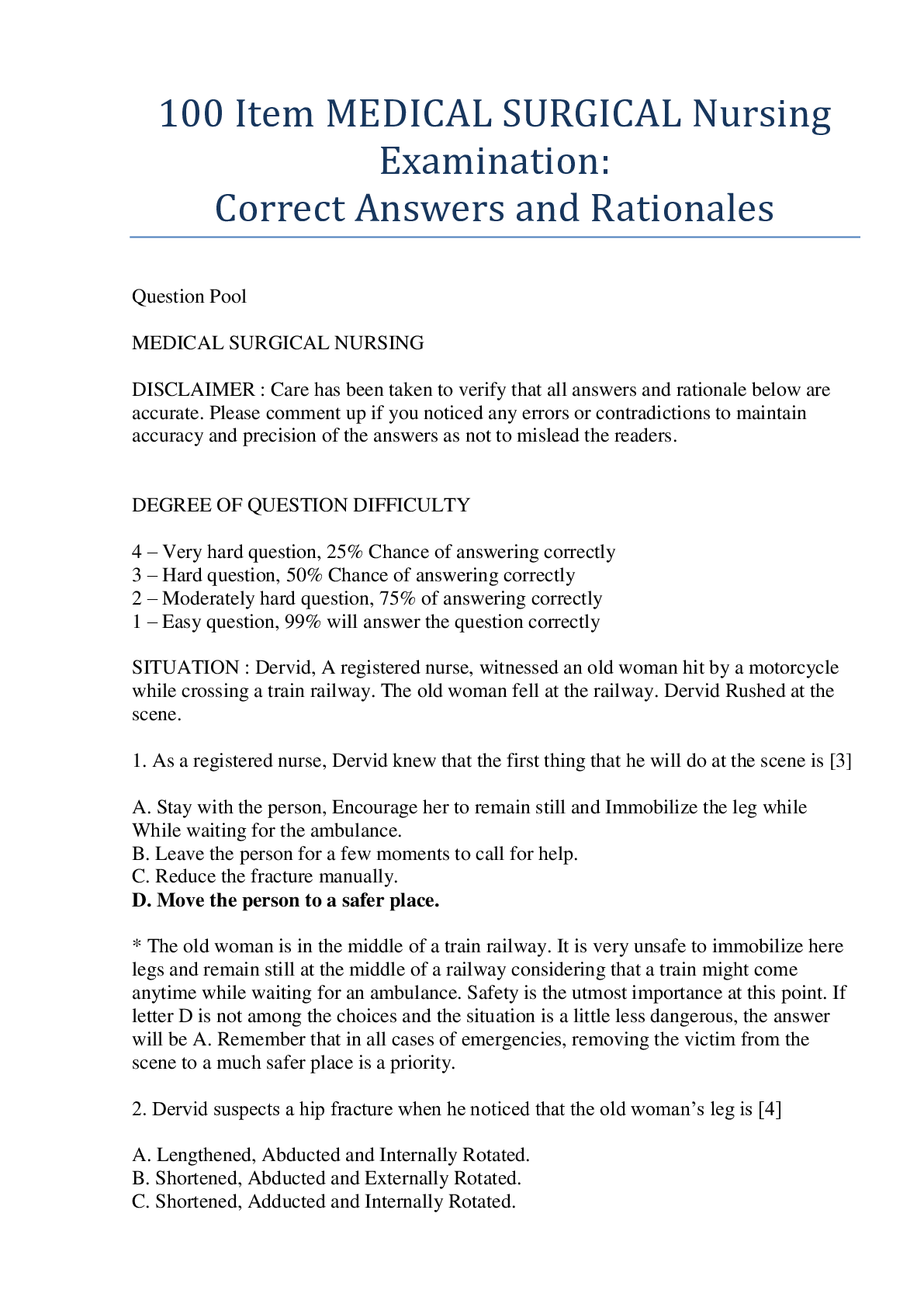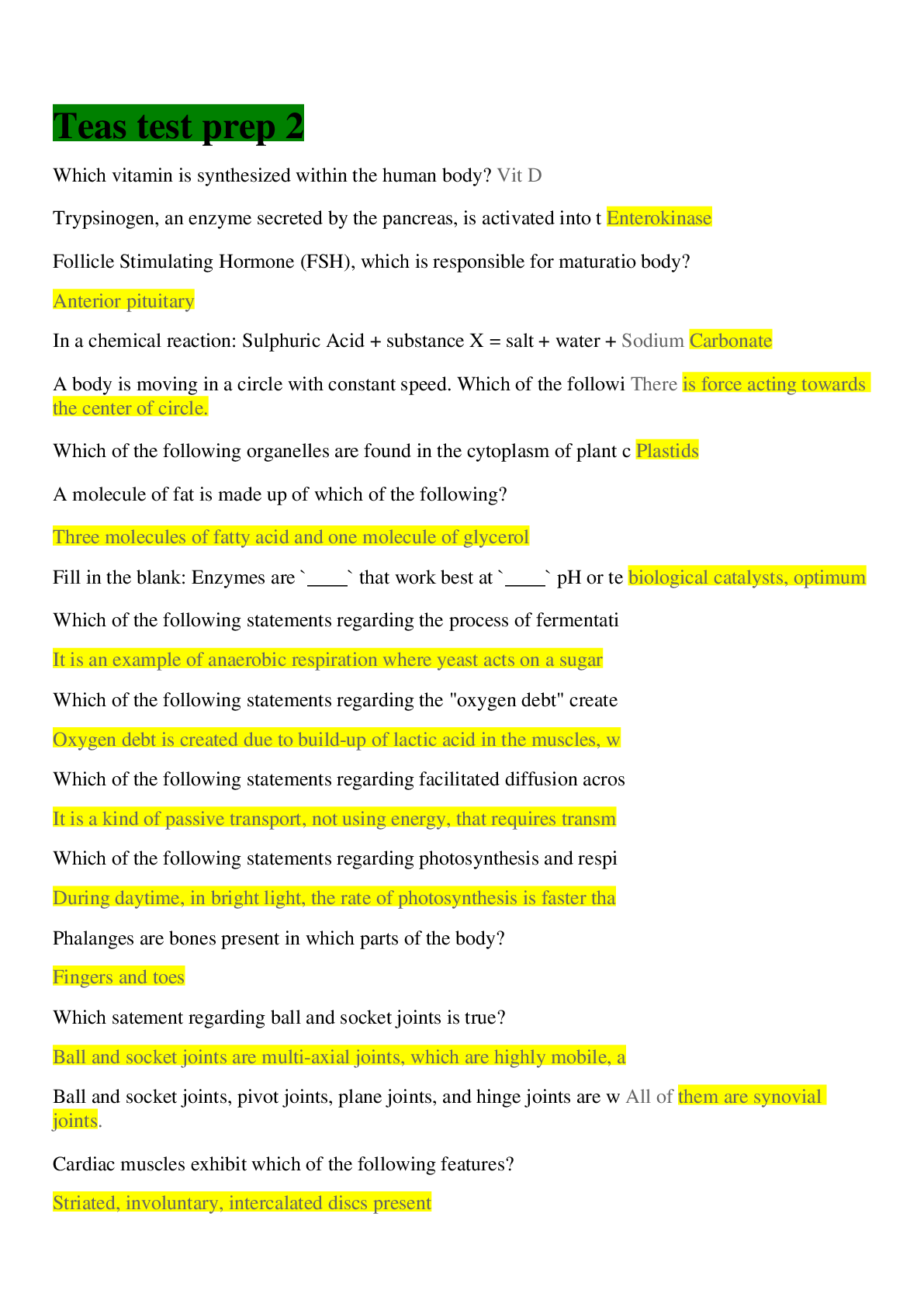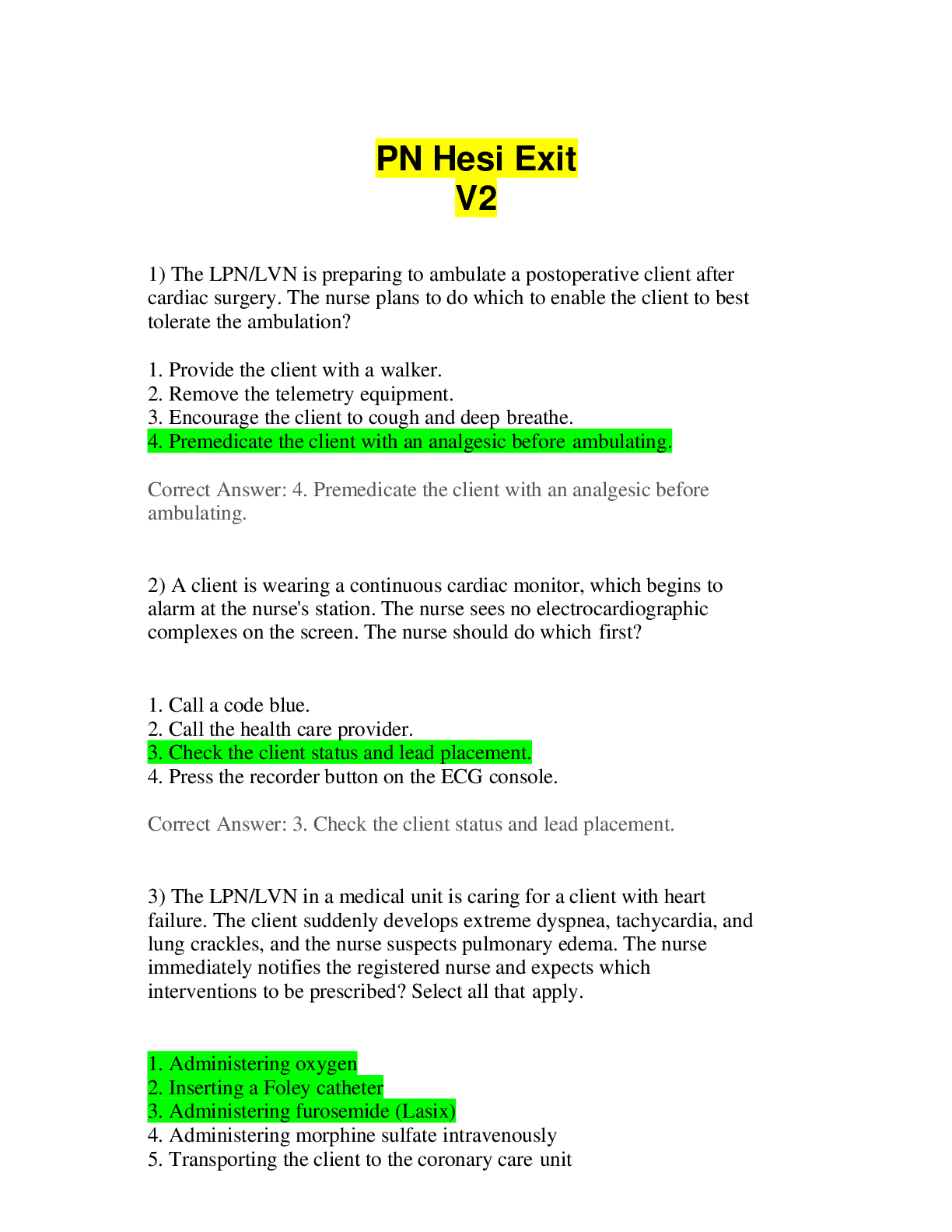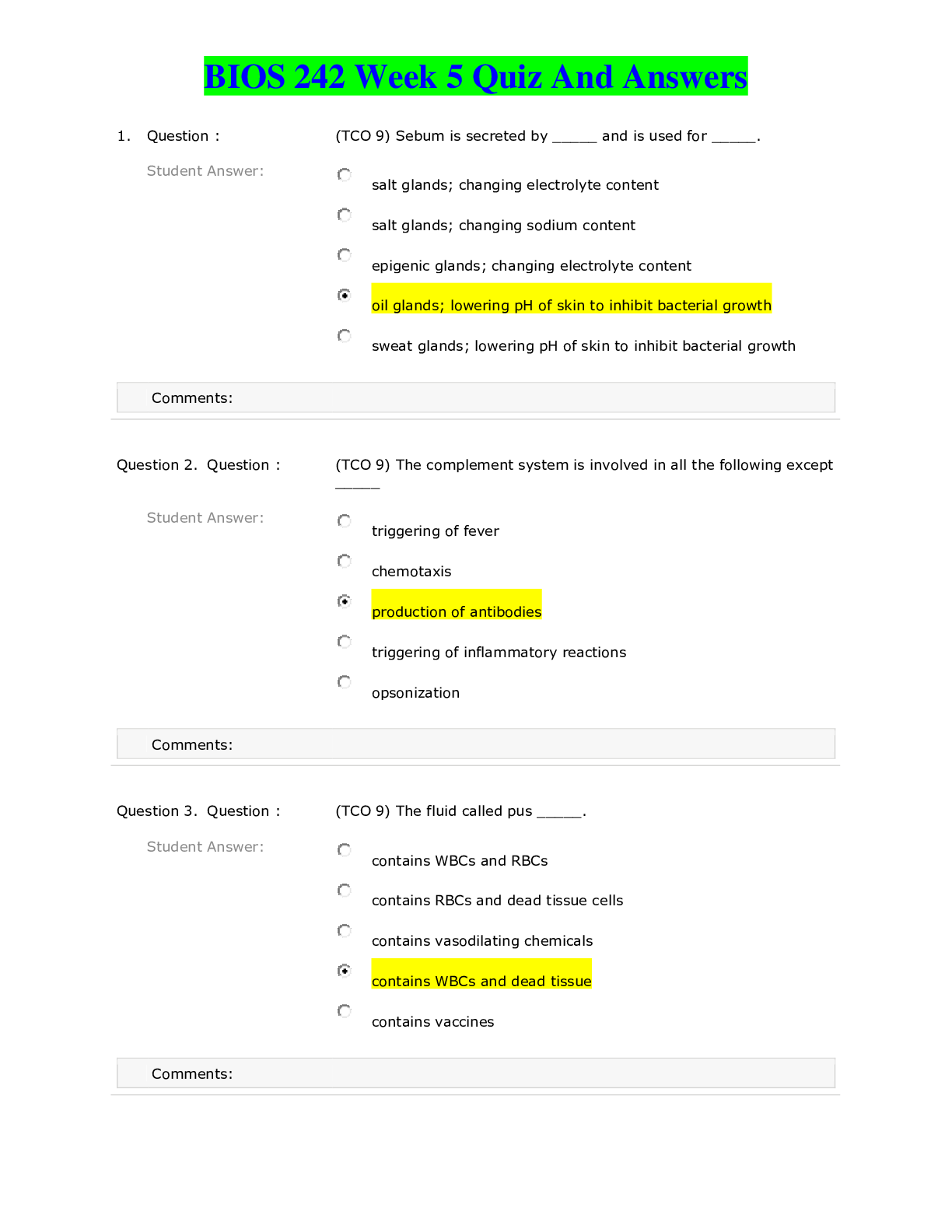Medical Surgical Nursing > EXAM > Senior Seminar Med Surg Quiz 2 |Verified with 100% Correct Answers (All)
Senior Seminar Med Surg Quiz 2 |Verified with 100% Correct Answers
Document Content and Description Below
Senior Seminar Med Surg Quiz 2 |Verified with 100% Correct Answers The nurse is conducting a session about the principles of first aid and is discussing the interventions for a snakebite to an extr... emity. The nurse should inform those attending the session that the first priority intervention in the event of this occurrence is which action? 1. Immobilize the affected extremity 2. Remove jewelry and constricting clothing from the victim 3. Place the extremity in a position so that it is below the level of the heart 4. Move the victim to a safe area away from the snake and encourage the victim to rest. A client calls the ED and tells the nurse that he came directly into contact with poison ivy shrubs. The client tells the nurse that he cannot see anything on the skin and asks the nurse what to do. The nurse should make which response? 1. "Come to the ED." 2. "Apply calamine lotion immediately to exposed skin areas." 3. "Take a shower immediately, lathering and rinsing several times." 4. "It is not necessary to do anything if you cannot see anything on your skin." A client is being admitted to the hospital for treatment of acute cellulitis of lower left leg. During the admission assessment, the nurse expects to note which finding? 1. An inflammation of the epidermis only 2. A skin infection of the dermis and underlying hypodermis 3. An acute superficial infection of the dermis and lymphatics 4. An epidermal and lymphatic infection caused by Staphylococcus The clinic nurse assesses the skin of a client with psoriasis after the client has used a new topical treatment for 2 months. The nurse identifies which characteristics as improvement in the manifestations of psoriasis? Select all that apply 1. Presence of striae 2. Palpable radial pulses 3. Absence of any ecchymosis on the extremities 4. Thinner and decrease number of reddish papules 5. Scarce amount of silvery-white scaly patches on the arms The clinic nurse notes that the HCP has documented a diagnosis of herpes zoster (shingles) in the client's chart. Based on an understanding of the cause of this disorder, the nurse determines that this definitive diagnosis was made by which diagnostic test? 1. Positive patch test 2. Positive culture results 3. Abnormal biopsy results 4. Wood's light examination indicative of infection A client returns to the clinic for follow-up treatment following a skin biopsy of a suspicious lesion performed 1 week ago. The biopsy report indicates that the lesion is a melanoma. The nurse understands that melanoma has which characteristics? Select all that apply. 1. Lesion is painful to touch 2. Lesion is highly metastatic 3. Lesion is a nevus that has changes in color 4. Skin under the lesion is reddened and warm to touch 5. Lesion occurs in body area exposed to outdoor sunlight When assessing a lesion diagnosed as basal cell carcinoma, the nurse most likely expects to note which findings? Select all that apply 1. An irregularly shaped lesion 2. A small papule with a dry, rough scale 3. A firm, nodular lesion topped with crust 4. A pearly papule with a central crater and a waxy border 5. Location in the bald spot atop the head that is exposed to outdoor sunlight A client arriving at the ED has experienced frostbite to the right hand. Which finding would the nurse note on assessment of the client's hand? 1. A pink, edematous hand 2. Fiery red skin with edema in the nail beds 3. Black fingertips surrounded by an erythematous rash 4. A white color to the skin, which is insensitive to touch The evening nurse reviews the nursing documentation in a client's chart and notes that the day nurse has documented that the client has a stage II pressure ulcer in the sacral area. Which finding would the nurse expect to note on assessment of the client's sacral area? 1. Intact skin 2. Full-thickness skin loss 3. Exposed bone, tendon, or muscle 4. Partial thickness skin loss of the dermis An adult client was burned in an explosion. The burn initially affected the client's entire face (anterior half of the head) and the upper half of the anterior torso, and there were circumferential burns to the lower half of both arms. The client's clothes caught on fire, and the client ran, causing subsequent burn injuries to the posterior surface of the head and upper half of the posterior torso. Using the rule of nines, what would be the extent of the burn injury? 1. 18% 2. 24% 3. 36% 4. 48% The nurse is preparing to care for a burn client scheduled for an escharotomy procedure being performed for a third-degree circumferential arm burn. The nurse understands that which finding is the anticipated therapeutic outcome of the escharotomy? 1. Return of distal pulses 2. Brisk bleeding from the site 3. Decreasing edema formation 4. Formation of granulation tissue A client is undergoing fluid replacement after being burned on 20% of her body 12 hours ago. The nursing assessment reveals a blood pressure of 90/50 mm Hg, a pulse rate of 110 bpm, and a urine output of 20 mL over the past hour. The nurse reports the findings to the HCP and anticipates which prescription? 1. Transfusing 1 unit of packed RBCs 2. Administering a diuretic to increase urine output 3. Increasing the amount of IV lactated ringers solution administered per hour 4. Changing the IV lactated ringers solution to one that contains 5% dextrose in water A client is brought to the ED with partial-thickness burns to his face, neck, arms, and chest after trying to put out a car fire. The nurse should implement which nursing actions for this client? Select all that apply 1. Restrict fluids 2. Assess for airway patency 3. Administer O2 as prescribed 4. Place a cooling blanket on the client 5. Elevate extremities if no fractures are present 6. Prepare to give oral pain medication as prescribed The nurse is caring for a client who sustained superficial partial-thickness burns on the anterior lower legs and anterior thorax. Which finding does the nurse expect to note during the resuscitation/emergent phase of the burn injury? 1. Decreased HR 2. Increased urine output 3. Increased BP 4. Elevated hematocrit The nurse manager is planning the clinical assignments for the day. Which staff members cannot be assigned to care for a client with herpes zoster? Select all that apply 1. The nurse who never had roseola 2. The nurse who never had mumps 3. The nurse who never had chickenpox 4. The nurse who never had German measles 5. The nurse who never received the varicella zoster vaccine A client arrives at the ED following a burn injury that occurred in the basement at home, and an inhalation injury is suspected. What would the nurse anticipate to be prescribed for the client? 1. 100% oxygen via an aerosol mask 2. Oxygen via nasal cannula at 6 L/min 3. Oxygen via nasal cannula at 15 L/min 4. 100% oxygen via a tight-fitting, nonrebreather face mask The nurse is administering fluids IV as prescribed to a client who sustained superficial partial-thickness burn injuries of the back and legs. In evaluating the adequacy of fluid resuscitation, the nurse understands that which assessment would provide the most reliable indicator for determining the adequacy? 1. Vital signs 2. Urine output 3. Mental status 4. Peripheral pulses The nurse manager is observing a new nursing graduate caring for a burn client in protective isolation. The nurse manager intervenes if the new nursing graduate planned to implement which unsafe component of protective isolation technique? 1. Using sterile sheets and linens 2. Performing strict hand-washing technique 3. Wearing gloves and a gown only when giving direct care to the patient 4. Wearing protective garb, including a mask, gloves, cap, shoe covers, gowns, and plastic apron The nurse is caring for a client following an autograft and grafting to a burn would on the right knee. What would the nurse anticipate to be prescribed for the client? 1. Out-of-bed activities 2. Bathroom privileges 3. Immobilization of the affected leg 4. Placing the affected leg in a dependent position The nurse is caring for a client who suffered an inhalation injury from a wood stove. The carbon monoxide blood report reveals a level of 12%. Based on this level, the nurse would anticipate noting which sign in the client? 1. Coma 2. Flushing 3. Dizziness 4. Tachycardia The nurse is reviewing the lab results of a client diagnosed with multiple myeloma. Which would the nurse expect to note specifically in this disorder? 1. Increased calcium level 2. Increased WBCs 3. Decreased BUN levels 4. Decreased number of plasma cells in the bone marrow The nurse is creating a plan of care for the client with multiple myeloma and includes which priority intervention in the plan? 1. Encouraging fluids 2. Providing frequent oral care 3. Coughing and deep breathing 4. Monitoring RBC count When caring for a client with an internal radiation implant, the nurse should observe which principles? Select all that apply 1. Limiting the time with the client to 1 hour per shift 2. Keeping pregnant women out of the client's room 3. Placing the client in a private room with a private bath 4. Wearing a lead shield when providing direct client care 5. Removing the dosimeter film badge when entering the client's room 6. Allowing individuals younger than 16 years in the room as long as they are 6 feet away from the client. While giving care to a client with an internal cervical radiation implant, the nurse finds the implant in the bed. The nurse should take which initial action? 1. Call the HCP 2. Reinsert the implant into the vagina 3. Pick up the implant with gloved hands and flush it down the toilet 4. Pick up the implant with long-handled forceps and place it in a lead container The nurse should plan to implement which intervention in the care of a client experiencing neutropenia as a result of chemotherapy? 1. Restrict all visitors 2. Restrict fluid intake 3. Teach the client and family about the need for hand hygiene 4. Insert an indwelling urinary catheter to prevent skin breakdown The home health care nurse is caring for a client with cancer who is complaining of acute pain. The most appropriate determination of the client's pain should include which assessment? 1. The client's pain rating 2. Nonverbal cues from the client 3. The nurse's impression of the client's pain 4. Pain relief after appropriate nursing intervention The nurse is caring for a client who is post op following a pelvic exenteration and the HCP changes the client's diet from NPO status to clear liquids. The nurse should check which priority item before administering the diet? 1. Bowel sounds 2. Ability to ambulate 3. Incision appearance 4. Urine specific gravity A client is admitted to the hospital with a suspected diagnosis of Hodgkin's disease. Which assessment finding would the nurse expect to note specifically in the client? 1. Fatigue 2. Weakness 3. Weight gain 4. Enlarged lymph nodes During the admission assessment of a client with advanced ovarian cancer, the nurse recognizes which manifestation as typical of the disease? 1. Diarrhea 2. Hypermenorrhea 3. Abnormal bleeding 4. Abdominal distention The nurse is caring for a client with lung cancer and bone metastasis. What signs and symptoms would the nurse recognize as indications of a possible oncological emergency? Select all that apply 1. Facial edema in the morning 2. Weight loss of 20 lb in 1 month 3. Serum calcium level of 12 mg/dL 4. Serum sodium level of 136 mg/dL 5. Serum potassium level of 3.4 mg/dL 6. Numbness and tingling of the lower extremities A client who has been receiving radiation therapy for bladder cancer tells the nurse that it feels as if she is voiding through the vagina. The nurse interprets that the client may be experiencing which condition? 1. Rupture of the bladder 2. The development of a vesicovaginal fistula 3.Extreme stress caused by the diagnosis of cancer 4. Altered perineal sensation as a side effect of radiation therapy The nurse is instructing a client to perform a TSE. The nurse should provide the client with which information about the procedure? 1. To examine the testicles while lying down 2. That the best time for the examination is after a shower 3. To gently feel the testicle with 1 finger to feel for a growth 4. That TSEs should be done at least every 6 months The nurse is conducting a history and monitoring lab values on a client with multiple myeloma. What assessment findings should the nurse expect to note? Select all that apply 1. Pathological fracture 2. Urinalysis positive for nitrates 3. Hgb level of 15.5 g/dL 4. Calcium level of 8.6 mg/dL 5. Serum creatinine level of 2.0 mg/dL A gastrectomy is performed on a client with gastric cancer. In the immediate postop period, the nurse notes bloody drainage from the NG tube. The nurse should take which most appropriate action? 1. Measure abdominal girth 2. Irrigate the NG tube 3. Continue to monitor the drainage 4. Notify the HCP The nurse is teaching a client about the risk factors associated with colorectal cancer. The nurse determines that further teaching is necessary related to colorectal cancer if the client identifies which item as an associated risk factor? 1. Age younger than 50 years 2. History of colorectal polyps 3. Family history of colorectal cancer 4. Chronic inflammatory bowel disease The nurse is assessing the perineal wound in a client who has returned from the OR following an abdominal perineal resection and notes serosanguineous drainage from the wound. Which nursing intervention is most appropriate? 1. Clamp the surgical drain 2. Change the dressing as prescribed 3. Notify the HCP 4. Remove and replace the perineal packing The nurse is assessing the colostomy of a client who has had an abdominal perineal resection for a bowel tumor. Which assessment finding indicates that the colostomy is beginning to function? 1. The passage of flatus 2. Absent bowel sounds 3. The client's ability to tolerate food 4. Bloody drainage from the colostomy The nurse is reviewing the history of a client with bladder cancer. The nurse expects to note documentation of which most common sign or symptom of this type of cancer? 1. Dysuria 2. Hematuria 3. Urgency on urination 4. Frequency of urination The nurse is assessing a client who has a new ureterostomy. Which statement by the client indicates the need for more education about urinary stoma care? 1. "I change my pouch every week." 2. "I change the appliance in the morning." 3. "I empty the urinary collection bag when it is 2/3 full." 4. "When I'm in the shower I direct the flow of water away from my stoma." A client with carcinoma of the lung develops SIADH as a complication of the cancer. The nurse anticipates that the HCP will request which prescriptions? Select all that apply 1. Radiation 2. Chemo 3. Increased fluid intake 4. Decreased oral sodium intake 5. Serum sodium level determination 6. Medication that is antagonistic to antidiuretic hormone The nurse is monitoring a client for signs and symptoms related to superior vena cava syndrome. Which is an early sign of this oncological emergency? 1. Cyanosis 2. Arm edema 3. Periorbital edema 4. Mental status changes As part of chemo education, the nurse teaches a female client about the risk for bleeding and self-care during the period of greatest bone marrow suppression. The nurse understands that further teaching is needed if the client makes which statement? 1. "I should avoid blowing my nose." 2. "I may need a platelet transfusion if my platelet count is too low." 3. "I'm going to take aspirin for my headache as soon as I get home." 4. "I will count the number of pads and tampons I use when menstruating." The community health nurse is instructing a group of young female clients about BSE. The nurse should instruct the clients to perform the examination at which time? 1. At the onset of menstruation 2. Every month during ovulation 3. Weekly at the same time of day 4. 1 week after menstruation begins A client is diagnosed as having a bowel tumor. The nurse should monitor the client for which complications of this type of tumor? Select all that apply 1. Flatulence 2. Peritonitis 3. Hemorrhage 4. Fistula formation 5. Bowel perforation 6. Lactose intolerance The nurse is caring for a client following a mastectomy. Which nursing intervention would assist in preventing lymphedema of the affected arm? 1. Placing cool compresses on the affected arm 2. Elevating the affected arm on a pillow above heart level 3. Avoiding arm exercises in the immediate post op period 4. Maintaining an IV site below the AC area on the affected side A client is brought to the ED in an unresponsive state, and a diagnosis of hyperosmolar hyperglycemic syndrome is made. The nurse would immediately prepare to initiate which anticipated HCP's prescription? 1. Endotracheal intubation 2. 100 units of NPH insulin 3. IV infusion of normal saline 4. IV infusion of sodium bicarb An external insulin pump is prescribed for a client with DM. When the client asks the nurse about the functioning of the pump, the nurse bases the response on which information about the pump? 1. It is timed to release programmed doses of either short-duration or NPH insulin into the bloodstream at specific intervals 2. It continuously infuses small amounts of NPH insulin into the bloodstream while regularly monitoring blood glucose levels 3. It is surgically attached to the pancreas and infuses regular insulin into the pancreas. This releases insulin into the bloodstream. 4. It administers a small continuous dose of short-duration insulin subQ. The client can self-administer an additional bolus dose from the pump before each meal A client with a diagnosis of DKA is being treated in the ED. Which findings support this diagnosis? Select all that apply 1. Increase in pH 2. Comatose state 3. Deep, rapid breathing 4. Decreased urine output 5. Elevated blood glucose level The nurse teaches a client with DM about differentiating between hypoglycemia and ketoacidosis. The client demonstrates an understanding of the teaching by stating that a form of glucose should be taken if which symptom or symptoms develop? Select all that apply 1. Polyuria 2. Shakiness 3. Palpitations 4. Blurred vision 5. Lightheadedness 6. Fruity breath odor A client with DM demonstrates acute anxiety when admitted to the hospital for the treatment of hyperglycemia. What is the appropriate intervention to decrease the client's anxiety? 1. Administer a sedative 2. Convey empathy, trust, and respect toward the client 3. Ignore the signs and symptoms of anxiety, anticipating that they will soon disappear 4. Make sure that the client is familiar with the correct medical terms to promote understanding of what is happening The nurse provides instructions to a client newly diagnosed with type 1 DM. The nurse recognizes accurate understanding of measures to prevent DKA when the client makes which statement? 1. "I will stop taking my insulin if I'm too sick to eat." 2. "I will decrease my insulin dose during times of illness." 3. "I will adjust my insulin dose according to the level of glucose in my urine." 4. "I will notify my HCP if my blood glucose level is higher than 250 mg/dL." A client is admitted to a hospital with a diagnosis of DKA. The initial blood glucose level is 950 mg/dL. A continuous IV infusion of short-acting insulin is initiated, along with IV rehydration with normal saline. The serum glucose level is now decreased to 240 mg/dL. The nurse would next prepare to administer which medication? 1. An ampule of 50% dextrose 2. NPH insulin subQ 3. IV fluids containing dextrose 4. Phenytoin for the prevention of seizures The nurse is monitoring a client newly diagnosed with DM for signs of complications. Which sign or symptom, if exhibited in the client, indicates that the client is at risk for chronic complications of DM if the blood glucose is not adequately managed? 1. Polyuria 2. Diaphoresis 3. Pedal edema 4. Decreased respiratory rate The nurse is preparing a plan of care for a client with DM who has hyperglycemia. The nurse places priority on which client problem? 1. Lack of knowledge 2. Inadequate fluid volume 3. Compromised family coping 4. Inadequate consumption of nutrients The home health nurse visits a client with a diagnosis of type 1 DM. The client relates a history of vomiting and diarrhea and tells the nurse that no food has been consumed for the last 24 hours. Which additional statement by the client indicates a need for further teaching? 1. "I need to stop my insulin." 2. "I need to increase my fluid intake." 3. "I need to monitor my blood glucose every 3-4 hours." 4. "I need to call the HCP because of these symptoms." The nurse is caring for a client after hypophysectomy and notes clear nasal drainage from the client's nostril. The nurse should take which initial action? 1. Lower the head of the bed 2. Test the drainage for glucose 3. Obtain a culture of the drainage 4. Continue to observe the drainage The nurse is admitting a client who is diagnosed with SIADH and has serum sodium of 118 mEq/L. Which HCP prescriptions should the nurse anticipate receiving? Select all that apply 1. Initiate an infusion of 3% NaCl 2. Administer IV furosemide 3. Restrict fluids to 800mL over 24 hours 4. Elevate the head of the bed to high Fowler's 5. Administer a vasopressin antagonist as prescribed A client is admitted to an ED, and a diagnosis of myxedema coma is made. Which action should the nurse prepare to carry out initially? 1. Warm the client 2. Maintain a patent airway 3. Administer thyroid hormone 5. Administer fluid replacement The nurse is caring for a client admitted to the ED with DKA. In the acute phase, the nurse plans for which priority intervention? 1. Correct the acidosis 2. Administer 5% dextrose IV 3. Apply a monitor for an ECG 4. Administer short-duration insulin IV A client with type 1 DM calls the nurse to report recurrent episodes of hypoglycemia with exercising. Which statement by the client indicates an adequate understanding of the peak action of NPH insulin and exercise? 1. "I should not exercise since I am taking insulin." 2. "The best time for me to exercise is after breakfast." 3. "The best time for me to exercise is mid- to late afternoon." 4. "NPH is a basal insulin, so I should exercise in the evening." The nurse is completing an assessment on a client who is being admitted for a diagnostic workup for primary hyperparathyroidism. Which client complaint would be characteristic of this disorder? Select all that apply 1. Polyuria 2. Headache 3. Bone pain 4. Nervousness 5. Weight gain The nurse is teaching a client with hyperparathyroidism how to manage the condition at home. Which response by the client indicates the need for additional teaching? 1. "I should limit my fluids to 1 liter per day." 2. "I should use my treadmill or go for walks daily." 3. "I should follow a moderate- calcium, high-fiber diet." 4. "My alendronate helps to keep calcium from coming out of my bones." A client with a diagnosis of Addisonian crisis is being admitted to the ICU. Which findings will the interprofessional HCP focus on? Select all that apply 1. Hypotension 2. leukocytosis 3. Hyperkalemia 4. Hypercalcemia 5. Hypernatremia The nurse is monitoring a client who was diagnosed with type 1 DM and is being treated with NPH and regular insulin. Which manifestations would alert the nurse to the presence of a possible hypoglycemic reaction? Select all that apply 1. tremors 2. anorexia 3. irritability 4. nervousness 5. hot, dry skin 6. muscle cramps The nurse is performing an assessment on a client with pheochromocytoma. Which assessment data would indicate a potential complication associated with this disorder? 1. A urinary output of 50 mL/hr 2. A coagulation time of 5 minutes 3. A heart rate that is 90 bpm and irregular 4. A BUN level of 20 mg/dL The nurse is monitoring a client diagnosed with acromegaly who was treated with transsphenoidal hypophysectomy and is recovering in the ICU. Which findings should alert the nurse to the presence of a possible postop complication? Select all that apply 1. Anxiety 2. Leukocytosis 3. Chvostek's sign 4. Urinary output of 800 mL/hr 5. Clear drainage on nasal dripper pad The nurse performs a physical assessment on a client with type 2 DM. Findings include a fasting blood glucose level of 120 mg/dL, temp of 101F, pulse of 102 bpm, respirations of 22 br/min, and BP of 142/72 mmHg. Which finding would be the priority concern to the nurse? 1. pulse 2. respiration 3. temperature 4. BP The nurse is preparing a client with a new diagnosis of hypothyroidism for discharge. The nurse determines that the client understands discharge instructions if the client states that which signs and symptoms are associated with this diagnosis? Select all that apply 1. Tremors 2. Weight loss 3. Feeling cold 4. Loss of body hair 5. Persistent lethargy 6. Puffiness of the face A client has just been admitted to the nursing unit following thyroidectomy. Which assessment is the priority for this client? 1. Hypoglycemia 2. Level of hoarseness [Show More]
Last updated: 7 months ago
Preview 1 out of 45 pages

Loading document previews ...
Buy this document to get the full access instantly
Instant Download Access after purchase
Buy NowInstant download
We Accept:

Also available in bundle (1)
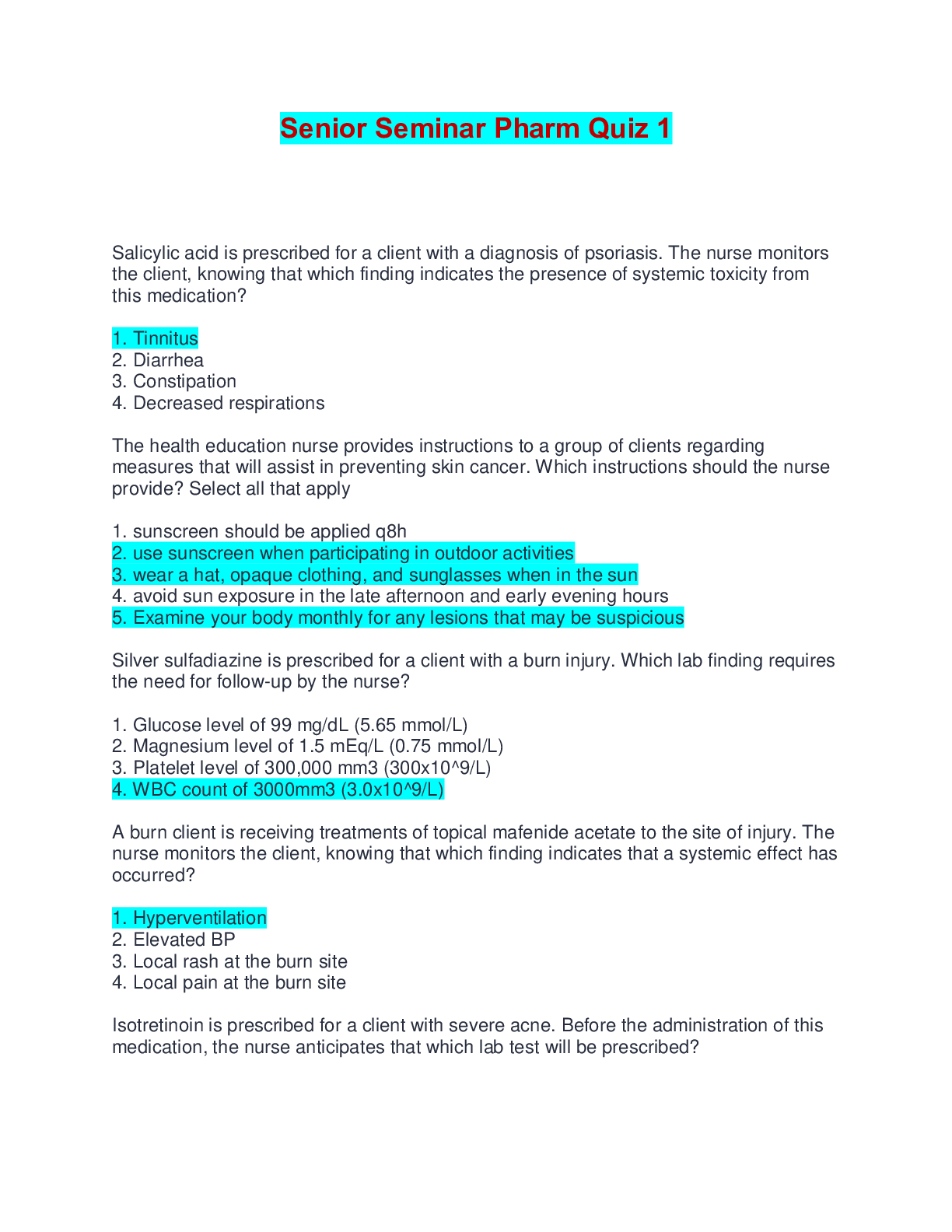
SENIOR SEMINAR QUIZ 1-6 BUNDLE
SENIOR SEMINAR QUIZ 1-6 BUNDLE
By Ajay25 7 months ago
$49.5
6
Reviews( 0 )
$22.00
Can't find what you want? Try our AI powered Search
Document information
Connected school, study & course
About the document
Uploaded On
Nov 20, 2024
Number of pages
45
Written in
Additional information
This document has been written for:
Uploaded
Nov 20, 2024
Downloads
0
Views
12

